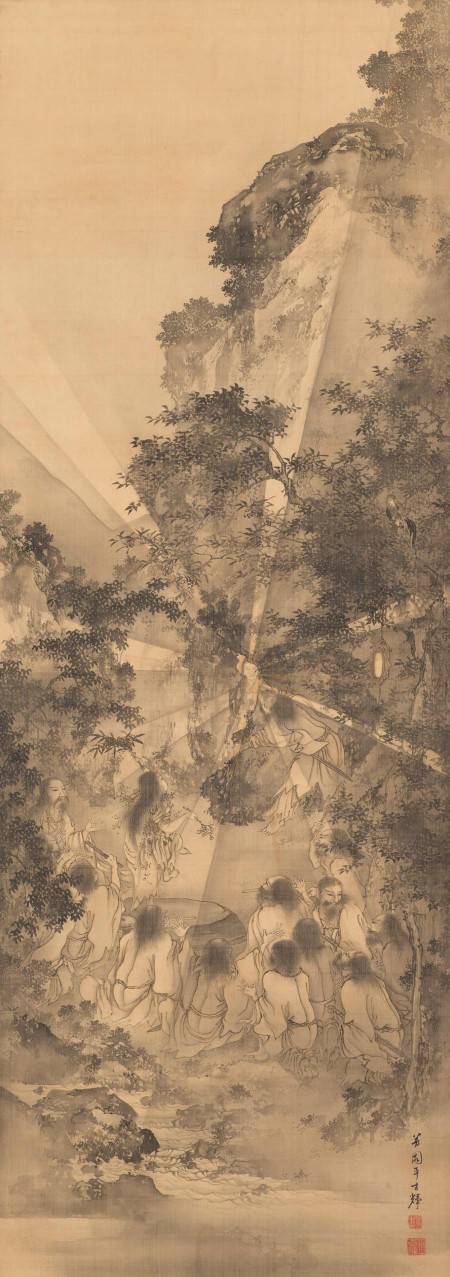When the Cincinnati Art Museum first announced its exhibition schedule for the coming season, I was thrilled to see that Masterpieces of Japanese Art was opening in February. At the time, I assumed it was going to be a traveling exhibit, perhaps from the Museum of Fine Arts in Boston, or from the Asian collections at the Nelson-Atkins or Cleveland Museum of Art.
Later, I was astonished to learn that it would feature works exclusive to the permanent archives of the Cincinnati Art Museum; works of art that had never or rarely been on display before, collected by Cincinnatians during their travels at the turn of the last century.

Model of an Ox Cart
Meiji period (1868–1912), 19th century
Lacquer
Gift of Mrs. Etsu Inagaki Sugimoto
1911.1371
The treasures in this show have been studiously selected from the Museum’s 3,000 piece collection of potential offerings to provide the viewer with an overview of Japanese Art beginning from the Heian period (794 -1159 A.D.), which saw a flowering of artistic activity in Japan, through the 19th century.
Selections illustrate the vast array of mediums and disciplines — ceramics, scrolls, armor, kimonos, ivory carvings, masks, and screens, to name a few – which help us to better understand the context and the role that art can play in preserving an extraordinary cultural heritage. As you view the exhibition, you’ll notice that some of the objects were done for utilitarian purposes and therefore no artist is named. Finely crafted, these pieces were probably not deemed art at the time they were made. An excellent example of this is “Suit of Armor”, Edo period (1615-1868). Although the armor was made for protection, its beauty is undeniable. It is composed of a multitude of materials and interwoven into a complex design. In the lower chest area of the armor you’ll see an exquisite and simple landscape design of a gold sun and silver waves, the only asymmetrical element in the entire suit of armor.
I was struck by how vivid the colors, glazes, and lacquers have remained; in some cases, for over a thousand years. The diversity of subject matter is also worth mentioning, drawn from literature, mythology, nature, fashion, and drama, and gives you a clearer understanding of the culture and the people. A pair of screens Scenes From The Tale of Genji not only helps to illustrate one of Japan’s greatest pieces of literature, but helps us visualize what court life must have been like during the Edo period. Like the book, it attempts to tell a story by unfolding multiple scenes on one screen.

Chiyo Mitsuhisa (Attr., Active circa 1532–55) 千代光久
Presentation of a Prince
Momoyama period (1573–1615), Late 16th or early 17th century
Six-fold screen
Ink, color, and gold on paper
The Thoms Collection; Given by Mrs. Murat H. Davidson in Honor of her Grandfather, Joseph C. Thoms
1982.6
Please take time to absorb the label copy, noting not only the historical significance of the object but its linkage to Cincinnati. One collector in particular is noteworthy, Maria Longworth Nichols Storer, an early proponent of Japanese art and also the founder of Rookwood Pottery. A ceramist herself, she was instrumental in bringing Kitaro Shirayamadani to Cincinnati, thereby introducing a Japanese sensitivity to the works of Rookwood Pottery.
Please don’t miss the sister exhibition, Modern Voices in Japanese Ceramics and Prints. While located at the entrance to the Masterpieces of Japanese Art, I recommend viewing it as the second offering because it is personally gratifying to discover the flow of history and aesthetics that have taken place over the years. The modern ceramics brings a contemporary flair to both the shape and glazing of the objects, while still relating directly to the ancient pottery. The modern prints, though mostly abstract, contain marks that directly relate to the brush strokes of the sumi paintings and calligraphy of the ancient works. Is there a Japanese psyche at play here?

Hōen (Taira) Yoshiteru 芳園平吉輝
Amaterasu
Meiji period (1868–1912)
Hanging scroll, ink and color on silk
Gift of Jeanann Gray Dunlap
2004.1130
The principles of irregularity, asymmetry and imperfection have been ingrained into the Japanese psyche. Beginning with the tea ceremony, the ceramic cups and bowls were consciously made to be irregular so no two would be alike. The same applies to Japanese calligraphy; the artist is encouraged to be in the moment, so that each writing would be unique unto itself. Being open enough to accept imperfection is correlated with freedom of expression.
Frank Satogata is an artist who lives and works in Cincinnati.



